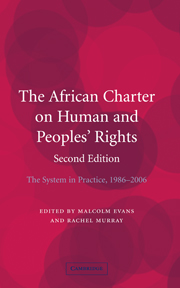Book contents
- Frontmatter
- Contents
- List of contributors
- Table of cases
- List of abbreviations
- Editors' Preface
- Introductory Preface: The African Charter and African Commission on Human and Peoples' Rights
- 1 The African Union and the Regional Human Rights System
- 2 The State Reporting Mechanism of the African Charter
- 3 Communications under the African Charter: Procedure and Admissibility
- 4 Evidence and Fact-Finding by the African Commission
- 5 Civil and Political Rights in the African Charter on Human and Peoples' Rights: Articles 1–7
- 6 Civil and Political Rights in the African Charter: Articles 8–14
- 7 Group Rights
- 8 The Role of Non-governmental Organisations and National Human Rights Institutions at the African Commission
- 9 A View from the Inside: The Role of the Secretariat
- 10 The Special Rapporteurs in the African System
- 11 Working Groups of the African Commission and their Role in the Development of the African Charter on Human and Peoples' Rights
- 12 The Creation of a New African Court of Justice and Human Rights
- 13 Protocol to the African Charter on the Rights of Women in Africa
- Bibliography
- Index
1 - The African Union and the Regional Human Rights System
Published online by Cambridge University Press: 01 July 2009
- Frontmatter
- Contents
- List of contributors
- Table of cases
- List of abbreviations
- Editors' Preface
- Introductory Preface: The African Charter and African Commission on Human and Peoples' Rights
- 1 The African Union and the Regional Human Rights System
- 2 The State Reporting Mechanism of the African Charter
- 3 Communications under the African Charter: Procedure and Admissibility
- 4 Evidence and Fact-Finding by the African Commission
- 5 Civil and Political Rights in the African Charter on Human and Peoples' Rights: Articles 1–7
- 6 Civil and Political Rights in the African Charter: Articles 8–14
- 7 Group Rights
- 8 The Role of Non-governmental Organisations and National Human Rights Institutions at the African Commission
- 9 A View from the Inside: The Role of the Secretariat
- 10 The Special Rapporteurs in the African System
- 11 Working Groups of the African Commission and their Role in the Development of the African Charter on Human and Peoples' Rights
- 12 The Creation of a New African Court of Justice and Human Rights
- 13 Protocol to the African Charter on the Rights of Women in Africa
- Bibliography
- Index
Summary
Introduction
In 2002, a new pan-continental regional institution for Africa, the African Union (AU), came into being, succeeding the discredited Organization of African Unity (OAU) which was dissolved. This notable event had its origins in the Sirte Declaration adopted by the OAU in September 1999, where African leaders had met to discuss the future of the OAU. There was an acceptance that the OAU, as originally conceived in the early 1960s, could no longer serve or satisfy the needs and aspirations of the Continent, and it was decided to replace it with a more dynamic organisation capable, on the one hand, of preserving and building upon the OAU's achievements and, on the other hand, of promoting Africa's role in the twenty-first century. The Sirte Declaration sought, inter alia, to address in an effective manner the new social, political and economic realities in Africa through a revitalised pan-African organisation that would have an enhanced role in meeting the needs of the peoples of the Continent. The AU, in all essential regards a political and economic institution, is loosely modeled on the European Union and constitutes the expression of a renewed determination in Africa to expedite political co-operation and economic integration. The AU is designed to provide the African continent with the legal and institutional framework to tackle successfully the twin challenges of the post-Cold War age and globalisation.
- Type
- Chapter
- Information
- The African Charter on Human and Peoples' RightsThe System in Practice 1986–2006, pp. 20 - 48Publisher: Cambridge University PressPrint publication year: 2008



